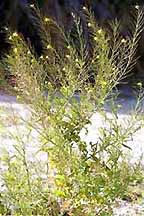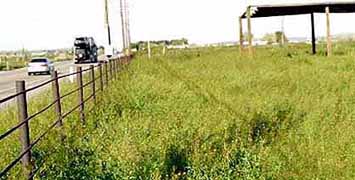CRAIG'S JUICY NATIVE GRASS GOSSIP
& Research
Ooopps...there Goes Another
North American Ecosystem, or Will
the Mojave Desert and the Sonoran Desert, along with the native
vegetation of four National Parks, disappear within our lifetime?
The Desert Exotic
Invasive Mustards or
"Dude, where's my Desert Ecosystem?" or "Did
you want Mustard on that desert ecosystem?" or "Got
Mustard?" or the
"No Mustards Left Behind" program
Edited, published and text
and photos are Copyright © 2005 by Craig Dremann of The Reveg
Edge (sm). P.O. Box 361, Redwood City, Cal. 94064. Phone
(650) 325-7333 email
The URL of this issue is: https://www.ecoseeds.com/juicy.gossip.seventeen.html
or https://www.ecoseeds.com/mustards.html
- No. 17- April-July, 2005
Index of all the Juicy Gossips at https://www.ecoseeds.com/juicy.html
The Three Desert Exotic Invasive
Mustards: "Exotic, Invasive Mustard
No. 1" Sisymbrium or London Rocket
 The "Exotic, Invasive Mustard No. 1" Sisymbrium
irio
The "Exotic, Invasive Mustard No. 1" Sisymbrium
irio
or London Rocket-- in the town of Baker, this exotic will
probably help cause the collapse of the Mojave ecosystem, and
finish the job started by the other exotics, like Red Brome, Filaree
and Schismus.

LUCERNE VALLEY, solid Mustard to the horizon,
off Cal. Hwy. 247 in abandoned agricultural lands. This species
was first seen in the Mojave as just a few acres along Cal. Hwy
247, just eight years ago, where a pipeline right-of-way had been
replanted. Now this species covers hundreds of miles of desert
roadsides, and is making solid stands in the richest soils, such
as the agricultural valleys and around the bases of creosote bushes.

Mustard along Cal. Hwy 58 in the town of Hinkley, a few miles
west of Barstow, solid in abandoned agriculture fields, moving
in from the roadsides.
Source of Original infestation:
1.) Caltrans contractors and roadside right-of-way projects
using contaminated straw used for roadside erosion control in
construction projects. (Hwy 247)
2.) Original source of California Mojave infestation = Cal.
Hwy 247.
3.) Current centers and major sources of infestations are
the abandoned agricultural fields around Hinkley and Lucerne Valley.
Infestation currently spread:
1.) Caltrans roadside grading of shoulder, spreading seeds
and plants along road edge, and Caltrans not making certified
weed-free straw mandatory for roadside construction projects.
Many thanks for the help in plant identifications, from:
---Dr. Ihsan A. Al-Shehbaz, Head of the Department of Asian Botany,
Missouri Botanical Garden, St. Louis, Missouri, checking specimens
December 2005
Back to main Saharan mustard
web page
Updated December 24, 2022 - The Reveg
Edge Ecological Restoration service